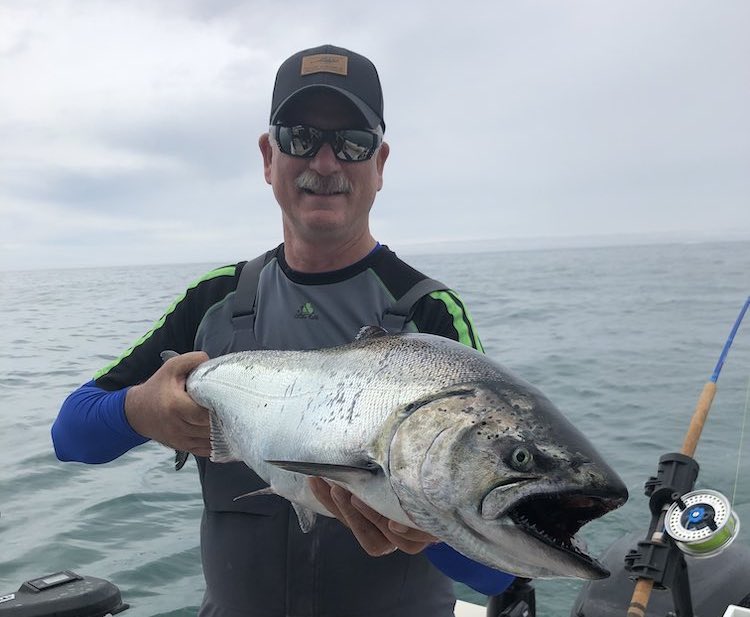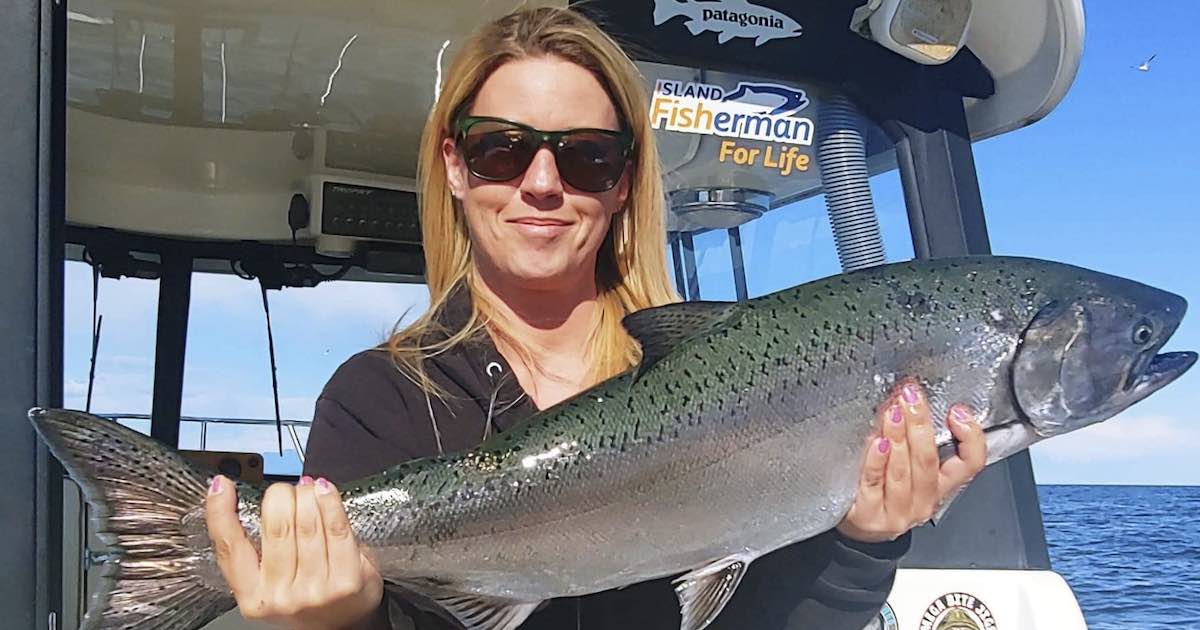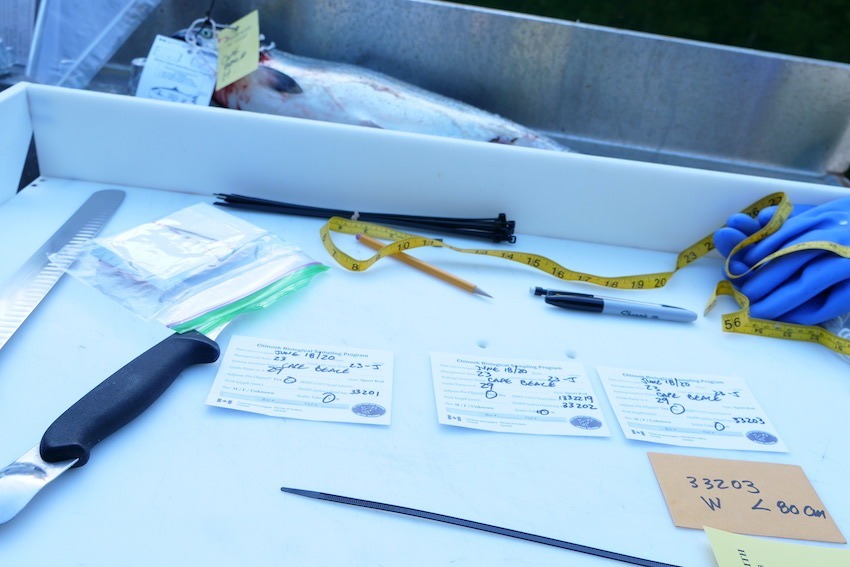
Talk with any group of hardcore anglers who extensively fish specific areas, and some will tell you that over the years they are able to follow specific patterns of fish. Some claim they can tell which home rivers fish are from by their body shape and run timing past certain locations. For example, Chinook stocks migrating to west coast Vancouver Island rivers generally follow within a few kilometers of the shoreline. In contrast, some Fraser Chinook migrate far offshore, and are not encountered in domestic fisheries until their route makes landfall near southern Vancouver Island. How do we know that? What is the science behind this, and how does DFO use our catch information to help inform catch estimation?

Pat Ahern and a June Hatchery Chinook
Each year DFO Stock Assessment undertakes recreational catch estimation to inform fisheries management and key stakeholders to help guide fishery decisions. Accuracy of catch estimation potentially impacts fishery decisions, and with so much riding on this, your catch data really does matter. The purpose of this article is to explore how catch estimation is currently undertaken, why it is important, and how we as concerned anglers can help.
Coded Wire Tagging (CWT)

Adipose fin-clipped hatchery Chinook
One of the longest running catch estimation methodologies along our Pacific Coast has been tracking returning stocks from specific rivers by injecting coded wire tags into the noses of hatchery smolts. The 1 mm-long CWTs must be electronically detected and recovered from fisheries in order to read their unique codes. Each code links back to a release of fish and the associated data that includes information such as stock, hatchery, release site, release date, and brood year. These CWT recoveries are used to determine survival rates, assess how many fish of a certain stock are harvested in a particular fishery, estimate the stock composition of the catch of a fishery, and evaluate hatchery rearing and release methods.

Brandi Lea with a Hatchery Chinook Nanaimo BC
How does it work? When anglers in BC retain adipose fin-clipped Chinook or coho, they can turn in their hatchery heads to designated head recovery freezers located at many popular marinas, tackle stores, and DFO offices. The heads are collected and examined for CWTs. When turning in heads, anglers need to complete a Sport Head Recovery label that gets attached to the head of each fish. On the label they write their catch location and date, and if they include their email address, DFO will provide a report back telling them where and when their fish was released.
Click here for full list of salmon sport head recovery depots
Not all hatchery-clipped fish have coded wire tags. In Canada approximately 10% of our hatchery Chinook are clipped, and all of these are also tagged. In the United States they clip most hatchery releases, but not all will have CWTs. Canada also clips most of our coho production, but only tags approximately 10%. Thus, when an angler receives their CWT report, not all heads will resolve to a release location, because not all fish are tagged with a CWT.

Esquimalt Anglers’ Association Sport Head Recovery Program
The bio-information anglers record on their head label is extremely valuable to fishery managers because it contains location and date of capture, and CWT containing heads provide information on migration route and timing. This allows managers to apply specific time-area measures in fisheries to avoid stocks of concern.
Every submitted head matters, even if it doesn’t contain a CWT! In the recreational fishery, we know the adipose clip rate in an area from the creel program. Since not all clipped heads (possibly containing CWTs) are returned by fishers, the ones that are returned are expanded to the total (by applying what is called an expansion factor). In areas of low head submissions, the expansion factor is high (i.e., if 5% of heads are returned, each CWT found will be multiplied by 20). A more desirable scenario is a high head submission, resulting in a low expansion factor (i.e., if 50% of heads are returned, each CWT found will be multiplied by 2).
So, it is critical that anglers turn in as many heads as possible in order to reduce expansion factors and achieve statistically reliable estimates.
Biosampling and Guide Logbooks
Another way for fishery managers to gather reliable catch estimates is through the Guide and Lodge Logbook Program. The Logbook Program provides guides with logbooks to record daily trip data. In the logbooks, detailed catch and release data for all species is recorded. This data includes, for example, halibut lengths, which helps improve catch estimates.

Guide Logbooks
Accurate data is crucial because if, for example, all guides simply default to recording their small halibut as 90 cm instead of providing the actual measurement, the difference can result in significant overestimates of catch. In situations where the recreational fishery is approaching the maximum Total Allowable Catch (TAC), those overestimates can result in the fishery being prematurely closed. Every catch record counts—and accuracy is our friend!
Otolith Samples

Otolith Samples
Biological sampling completed by guides and lodges is another important tool used to break the catch down into age and stock. Scientists can use DNA, scale, and otolith samples to tell a lot about your catch. For example, fish that appear to be wild (no adipose clip) are often of hatchery origin. In Barkley Sound, where I fish extensively, just under 90% of the fish sampled were determined to be of hatchery origin by looking for a hatchery thermal mark on the otoliths. This stock composition data is extremely helpful in determining if specific stocks of concern are encountered or not within specific areas and times. Stock composition analysis (from CWT, otoliths, and DNA combined) over several years can help assess the degree of risk for specific stocks encountered in certain fishery areas and can then inform management decisions around how to shape fisheries to take place in areas and times where risk is acceptably low.

Biosampling Tags
Guides interested in volunteering to complete logbooks and obtain biosamples are encouraged to contact their local area DFO Creel Coordinator from the list below:
- North Vancouver Island/Quatsino/Kyuquot: Kiana Matwichuk (250) 902-8869
- Nootka/Esperanza: Nick Bohlender (250) 830-4292
- Clayoquot/Barkley: Piper-Lynn Brady (250) 616-1213
- Port Renfrew: Brenda Wright (250) 618-2731
Avid Angler Program – Volunteers are the backbone
In addition to the Guide Logbook and biosampling program, DFO engages volunteer anglers to participate in the Avid Angler Program. Avid Anglers collect biosamples from both retained or kept fish as well as live released fish. Those avid anglers participating in the program are trained in release sampling protocols to help collect biosamples in the least harmful manner under a scientific license issued to each Avid Angler participant. Many dedicated anglers have stepped forward, and through their significant efforts, there are currently over 60,000 (and growing) individual data records which help provide fishery managers with greater resolution of stock composition, run timing, and spatial location of fishery encounters by individual Chinook stocks from specific river systems.

Last Cast Guiding
This season, DFO implemented retention fishery opportunities for Chinook in a number of Mainland Inlets – Jervis, Toba, Bute, and Broughton Archipelago (https://www.pac.dfo-mpo.gc.ca/fm-gp/salmon-saumon/fraser-chin-mgmt-gest-quin-eng.html). These opportunities are linked to ongoing efforts to increase our understanding of the stock composition and run timing of Chinook encountered in these areas. Similarly, it is vitally important that we gather biosampling stock composition data for the non-retention areas in order to help assess potential MSF opportunities going forward in future years. In short, we really need volunteers to help with data collection.
The Avid Angler program is currently looking for interested volunteers who plan to participate in these fisheries and will provide catch data and biosampling. Volunteers form the backbone of the program by helping gather important data to gain a better understanding of fishery encounters. Anglers who are willing to participate are encouraged to contact DFO Avid Angler Program Coordinator Patrik Zetterberg at Patrik.Zetterberg@dfo-mpo.gc.ca or 250-713-6084 to sign up and receive sample kits and logbooks.
Aerial (Overflight) Effort Estimates
DFO requires a combination of vessel counts (usually aerial overflights), guide logbook data, and dockside creel survey data to calculate recreational catch by species by area. The overflights provide an estimate of effort (boat trips). The logbook and creel survey data provide average catch-per-unit-effort (CPUE, or catch-per-vessel trip) for each day in each area.
Catch = total boat trips x average CPUE
So, for example, if the overflight observes 1,000 boats fishing, and the average catch per vessel as determined in the creel surveys was five Chinook, then the estimated catch for that area would be 1000 x 5 = 5,000 Chinook.
A common concern is that returning logbook data results in double counting of catch. There absolutely is no double counting of catch. To incorporate guide logbook data, DFO Stock Assessment staff subtract the number of guided trips (provided from logbooks) from the total boat trips, and add the amount of guided catch (provided from logbooks) as follows:
New catch estimate = (total boat trips – guided boat trips) x average catch per boat trip + log reported catch.
Since guides generally have a higher CPUE, when guides don’t submit logbook catch data, creel survey-based catch estimates will tend to be overestimated. This is detrimental particularly for quota species like halibut.
Internet Recreational Survey (iREC)
DFO also conducts an internet survey that is sent out to selected anglers. When you first purchase your license, you will receive an indication of which month has been selected for you to participate in the survey. To avoid survey bias, and to help ensure that anglers pay attention to how many fish they encounter on trips subject to an iREC survey, DFO will provide the angler with advance warning prior to the month they will be surveyed. At the conclusion of the survey month, anglers will receive a survey via email. Your accurate catch data is very important, so please take the time to participate, and when notified, it is a good idea to jot down your trip catch.
Dockside Creel Surveys

DFO Lucas Slyford Creel Survey at Westview Marina Tahsis BC
As discussed, DFO employs creel survey staff to interview anglers and guides when they return to their homeport. These creel surveys are vital to providing the backbone of catch estimation. Thus, it is important to participate fully in creel interviews when requested. For guides who are interviewed by creel surveyors, logbook entries for that trip are not double-counted, as detailed above. Creel surveyors are also responsible for biological sampling, and can be an important source of information for anglers, as well as an avenue to relay information and feedback to DFO staff.
Rockfish Descending Device Releases

Rockfish Descender connected to Downrigger
As of 2019, the carry and use of a rockfish barotrauma release device is mandatory. Studies have indicated very low survival for rockfish suffering barotrauma from being pulled up quickly to the surface from depth. This is similar to a human diver suffering from the bends. Barotrauma descenders work by simply taking the fish back down to the depth they were caught, where they are able to recover from barotrauma and swim away successfully. We are asking anglers to advise of rockfish released using a descending device when interviewed by a creel surveyor or surveyed via iREC. Similarly, guides who are completing logbooks need to record specifically how many rockfish, and which species, are released using descenders. This helps record successful releases and more accurately estimate recreational fishery release mortality.
Your Catch Counts
As avid tidal water anglers, we can work collectively as volunteers to help ensure our fishery is accountable for our catch, and our data informs scientific understanding of stock composition from biosampling. Our knowledge of run timing and fishery encounters with various Chinook stocks is a vital component in helping data-informed fishery management to shape sustainable future fisheries. Please consider helping – turn in your hatchery heads, provide Creel Survey staff your catch data when interviewed dockside, volunteer to join the Avid Angler Program, or—if you are a guide—join the Guide Logbook program.
Visit the Store
$34.99
$34.99
Featured Catch

Joel Unickow halibut (Photo: Rob Frawley Lucky Strike Sportfishing Tofino)







